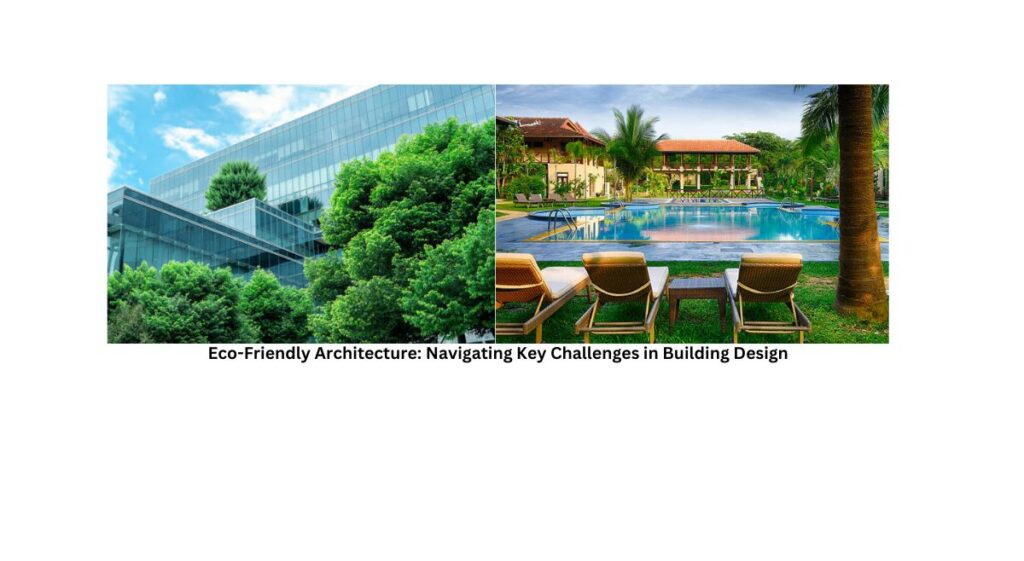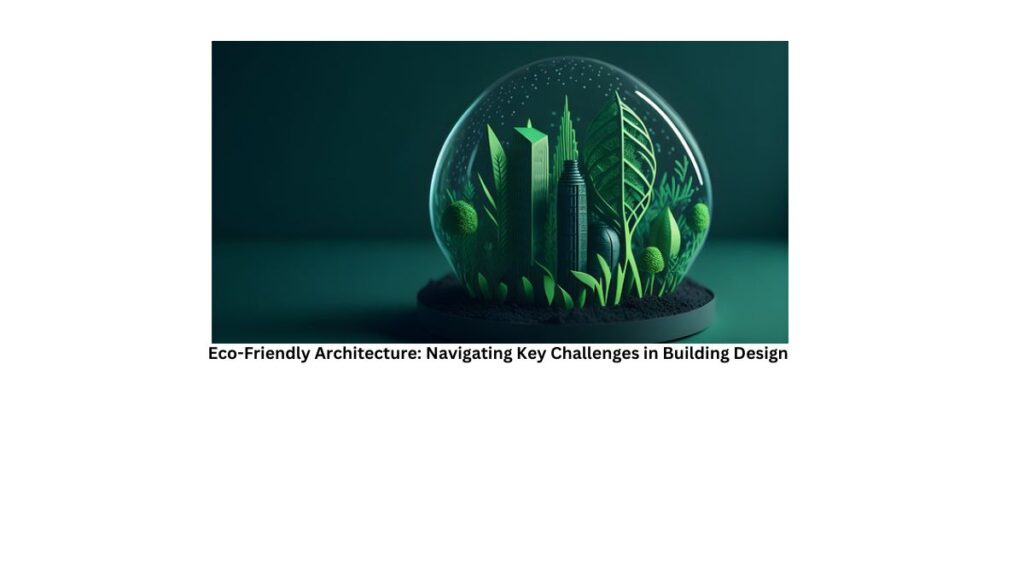Introduction:
Eco-Friendly Architecture: Navigating Key Challenges in Building Design

In the pursuit of sustainable living, eco-friendly architecture plays a pivotal role in shaping the future of our built environment. This article delves into the intricate world of sustainable building design, exploring the challenges that architects and designers face in their quest to create environmentally conscious structures.
What is Eco-friendly architecture and tell us about the major challenges of creating it?
- Understanding the Landscape of Eco-Friendly Architecture: Uncover the foundations of eco-friendly architecture and the principles that guide sustainable building design. Learn how these principles contribute to a greener and more energy-efficient world.
- Balancing Aesthetics and Sustainability: Explore the delicate balance between aesthetic appeal and sustainable design. Discover how architects grapple with the challenge of creating visually stunning structures while adhering to eco-friendly practices.
- Material Selection: The Green Conundrum: Delve into the complexities of choosing sustainable materials. Understand the impact of material selection on the overall eco-friendliness of a building and the challenges associated with sourcing and implementing green building materials.
- Energy Efficiency: Overcoming the Technical Hurdles: Unravel the technical challenges involved in achieving optimal energy efficiency. From innovative technologies to energy-efficient systems, this section explores the hurdles faced by architects in creating buildings that consume minimal energy.
- Cost Considerations: The Economics of Sustainability: Examine the economic challenges tied to eco-friendly architecture. Understand the upfront costs and long-term benefits associated with sustainable building practices and how architects navigate financial considerations in their projects.
- Regulatory Compliance: Navigating the Green Building Codes: Learn about the evolving landscape of green building codes and regulations. Explore the challenges architects face in adhering to and navigating through ever-changing environmental standards.
- Community Engagement and Education: Building Green Awareness: Recognize the importance of community engagement in sustainable architecture. Discover how architects work to educate and involve communities in the green building movement, overcoming challenges in fostering awareness and support.
- Climate Variability and Adaptability: Designing for Resilience: Address the challenges associated with designing buildings that can withstand climate variability. Explore the need for adaptability and resilience in the face of changing environmental conditions.
- Waste Management: Reducing the Environmental Footprint: Investigate the challenges related to waste management in construction projects. Learn about sustainable practices that aim to minimize the environmental footprint of building projects.
- Future Trends and Innovations: Paving the Way Forward: Conclude by exploring emerging trends and innovations in eco-friendly architecture. Understand how architects are pushing boundaries and overcoming challenges to lead the way towards a more sustainable and environmentally conscious future.
What is the green building design process?
The green building design process involves a systematic approach to creating structures that are environmentally responsible and resource-efficient throughout their lifecycle. Here is a general overview of the green building design process:

- Project Planning and Goal Setting:
- Establish project goals and objectives related to sustainability.
- Define the level of green certification (e.g., LEED, BREEAM) desired for the project.
- Consider site selection and orientation for optimal environmental performance.
- Site Analysis and Design:
- Assess the environmental context of the site, including climate, topography, vegetation, and local ecosystems.
- Optimize building placement and orientation to maximize natural light, reduce energy consumption, and take advantage of prevailing winds.
- Design for water management, considering issues like stormwater runoff, groundwater recharge, and landscaping that requires minimal irrigation.
- Energy Efficiency and Renewable Energy:
- Implement passive design strategies to optimize natural heating, cooling, and lighting.
- Integrate energy-efficient technologies and systems, such as high-performance insulation, energy-efficient HVAC systems, and energy-efficient lighting.
- Consider the incorporation of renewable energy sources like solar panels, wind turbines, or geothermal systems.
- Material Selection:
- Choose environmentally friendly and sustainable materials with low embodied energy and minimal environmental impact.
- Prioritize locally sourced materials to reduce transportation-related emissions.
- Consider materials with recycled content and those that are easily recyclable or biodegradable.
- Water Efficiency:
- Implement water-efficient technologies, such as low-flow fixtures, rainwater harvesting systems, and greywater recycling.
- Design landscapes that require minimal irrigation and use native or drought-resistant plants.
- Indoor Environmental Quality:
- Prioritize indoor air quality by selecting low-emission materials, using proper ventilation systems, and controlling pollutants.
- Optimize natural lighting and thermal comfort to enhance the overall indoor environment.
- Waste Management:
- Develop a construction waste management plan to minimize waste generation during the building process.
- Promote recycling and reuse of materials on-site.
- Life Cycle Assessment:
- Conduct a life cycle assessment to evaluate the environmental impact of the building from construction through occupancy and potential demolition.
- Consider the long-term sustainability and adaptability of the building.
- Certification and Compliance:
- Ensure compliance with relevant green building standards and codes.
- Pursue certification from recognized green building certification programs (e.g., LEED, BREEAM) to validate the project’s sustainability.
- Monitoring and Post-Occupancy Evaluation:
- Implement monitoring systems to track the building’s performance in terms of energy use, water consumption, and indoor air quality.
- Conduct post-occupancy evaluations to gather feedback from users and identify opportunities for improvement.
Throughout the green building design process, collaboration among architects, engineers, builders, and other stakeholders is crucial to achieving a holistic and sustainable outcome. The process requires ongoing innovation and adaptation to incorporate the latest advancements in sustainable technologies and practices.
What are the obstacles to green building construction?
While the adoption of green building practices is growing, there are several obstacles and challenges that can hinder the widespread implementation of sustainable construction. Some of the key obstacles include:

- Initial Cost Concerns:
- Higher Initial Investment: The upfront costs of incorporating green technologies and materials into construction can be higher than conventional methods. Many developers and clients may be reluctant to invest in sustainable features due to concerns about immediate financial returns.
- Lack of Awareness and Education:
- Limited Knowledge: There is often a lack of awareness and understanding about the benefits of green building among developers, architects, builders, and the general public. Education and outreach efforts are essential to promote the advantages of sustainable construction.
- Resistance to Change:
- Traditional Practices: Resistance to change and adherence to traditional construction methods can be a barrier. Many stakeholders may be comfortable with conventional building practices and may be hesitant to embrace new and innovative sustainable technologies.
- Perceived Complexity:
- Technical Complexity: Some perceive green building practices as technically complex, and there may be a lack of confidence in implementing sustainable technologies. This can be a challenge, especially for smaller construction firms with limited resources.
- Regulatory Barriers:
- Lack of Supportive Policies: In some regions, the absence of supportive policies and incentives for green building can hinder its adoption. Regulatory barriers and outdated building codes may not encourage or require sustainable construction practices.
- Limited Availability of Green Materials:
- Market Accessibility: The availability of environmentally friendly and sustainable materials can be limited in some regions. Additionally, the cost of such materials may be prohibitive, making them less accessible for certain projects.
- Short-Term Perspective:
- Focus on Immediate Returns: Developers and investors may prioritize short-term returns on investment over the long-term benefits of green building, leading to the neglect of sustainable features.
- Lack of Standardization:
- Inconsistent Standards: Lack of standardized green building practices and certification systems globally can lead to confusion and inconsistency in defining what constitutes a green building.
- Inadequate Skills and Training:
- Skills Gap: A shortage of professionals with expertise in green building design and construction can be a barrier. The industry needs more architects, engineers, and construction workers with the knowledge and skills to implement sustainable practices effectively.
- Financing Challenges:
- Limited Access to Green Financing: Financing options specifically tailored for green building projects may be limited. Financial institutions may not always offer favorable terms for sustainable construction, deterring developers from pursuing such projects.
- Market Perceptions:
- Consumer Perception: In some cases, consumers may not prioritize green features when purchasing or leasing properties, affecting the demand for sustainable buildings.
Conclusion
Addressing these obstacles requires a concerted effort from various stakeholders, including policymakers, industry professionals, financial institutions, and the public. Encouraging regulatory support, promoting education and training, and highlighting the long-term benefits of green building are essential steps toward overcoming these challenges.
By navigating these key challenges, the world of eco-friendly architecture is continually evolving, shaping a more sustainable and resilient future for generations to come.





